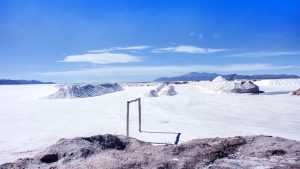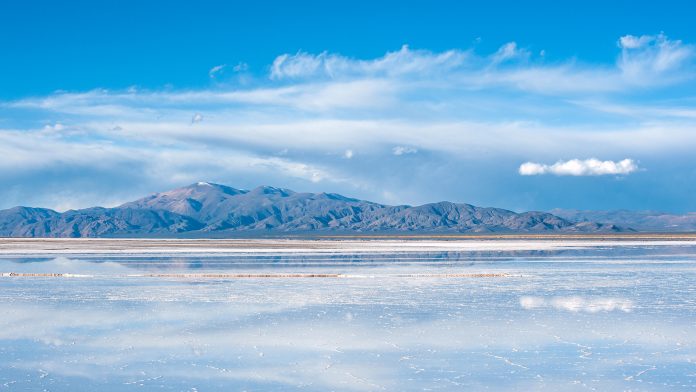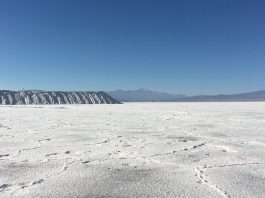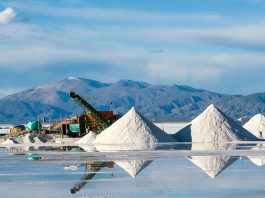The Wilson Center’s Benjamin Gedan and Sofía Schuchner explore the challenges and opportunities for Argentina’s lithium sector.
Argentina’s political and economic dramas have complicated its investment climate. Three years ago, 102 Japanese companies operated in Argentina. Today, there are only 70. Yet Argentina’s lithium industry remains attractive to Japanese mining companies, and the same is true for their counterparts in Australia, China, and the United States.
Indeed, even amid its recent tumult, Argentina’s lithium production has increased dramatically, from less than 1% of global production in 1994 to 7% in 2020. In January of this year, its lithium exports were worth $21m, a 63% increase from the previous year.
That success has much to do with the exploding demand for this mineral, an essential ingredient for batteries in electric vehicles (EVs). Thanks to sky-high lithium prices, investors have been willing to overlook an annual inflation rate that could reach 100% this year, and political infighting between President Alberto Fernández and Vice President Cristina Kirchner that has complicated economic policymaking.
The government’s role in the lithium sector
That said, Argentina’s lithium industry is in many ways immune to these ups and downs. Lithium is one of the few areas untouched by Argentina’s fierce partisan divisions. The governors of lithium-rich Catamarca, Jujuy, and Salta provinces, each from a different political party, sit on a regional co-ordination committee. They recently travelled together to Washington. That is significant, because under Argentina’s constitution, the provinces have authority over mining.

The national government is also on board. Argentina’s new finance minister, Sergio Massa, appointed Fernanda Ávila as mining secretary, borrowing her from Catamarca, where she held the same position. She has already met with international mining companies, including Livent and Rio Tinto.
Massa has an uphill battle reassuring investors about Argentina’s economic prospects. But the same is not true for Ávila. Livent, for example, is already producing 20,000 metric tons of lithium per year in its Mina Fenix in Catamarca. The company has completed its first expansion in Argentina, it is working on its second and evaluating a third, with the goal of producing 100,000 metric tons annually by 2030.
In March, Rio Tinto acquired the Salar del Rincón in Salta for $825m. It is operating a pilot plant using a new extraction technology designed to reduce environmental impacts, even as it raises output to 25,000 metric tons per year. Argentina’s lithium industry is expanding, despite the complicated politics that have disturbed economic policymaking.
Argentina’s advantage in the global lithium industry
Argentina’s reputation in the lithium industry also benefits from uncharacteristic predictability and openness. Private companies control the production of lithium, with the governments collecting taxes and royalties. The country’s national and provincial mining laws and regulations are seen as stable and pro-business. That is in contrast to Chile, where the state already plays a larger role and proposed legislation and constitutional reforms could make mining even more difficult.
Finally, Argentina has also avoided the type of organised local opposition that has kneecapped the mining industry in places like Bolivia’s mineral-rich Potosí.
Risks to Argentina’s lithium boom
That is not to say there are no risks to Argentina’s lithium boom times.
Matías Kulfas, Argentina’s former minister of productive development, emphasised the importance of building industries that rely upon lithium – a goal that still animates Argentina’s Peronist administration. That is a logical objective; building battery and EV industries would create jobs, increase export earnings, and reduce dependency on foreign manufacturers for Argentina’s transportation transition. In a partnership with the Chinese company Tianqi Lithium, Argentina’s state-owned energy company, YPF, already has plans to produce batteries.
That said, as Argentina considers opportunities to industrialise its lithium industry, it should be aware of the missteps in neighbouring Bolivia. Bolivia’s Law 928 established Yacimientos de Litio Bolivianos (YLB), a state-owned company that extracts and processes lithium. It allows private sector participation only in related industrial activities. That policy has limited foreign investment in the sector; a series of proposed international partnerships have fizzled, and Bolivia is not a major lithium producer, despite abundant mineral resources.
Though Argentina’s constitution gives control of minerals to the provinces, a growing role for the national government could similarly spook investors. YPF and Catamarca Minera y Energética Sociedad del Estado, for example, have signed an agreement for lithium exploration. That is a far cry from the nationalisation of lithium in Bolivia and Mexico, but it could raise concerns about the direction of Argentine public policy.
Argentina’s lithium industry is also vulnerable to the same environmental considerations that have limited the sector’s expansion in Chile. Specifically, there are widespread concerns about the heavy water use in the evaporation processes used to produce lithium from brine in Argentina’s salt flats. Fortunately, recent innovations, such as direct lithium extraction (DLE), have raised hopes of dramatically reducing water use. That would help Argentina avoid tensions with local communities and meet the sustainability requirements of lithium end users, including EV manufacturers and their customers.
While DLE would benefit Argentina’s lithium industry, however, other technological changes would be less welcome. Fears of high-priced lithium are leading to research into alternative battery technologies that would reduce the need for this mineral. That means that the predicted widespread adoption of EVs might not guarantee sustained demand for Argentina’s lithium.
For now, however, Argentina’s lithium sector holds tremendous promise, both for Argentina and for a world hungry for battery minerals.


Benjamin Gedan
Acting Director
Sofía Schuchner
Research Assistant
Wilson Center’s Latin American Program
https://www.wilsoncenter.org/program/latin-american-program
Please note, this article will also appear in the twelfth edition of our quarterly publication.









